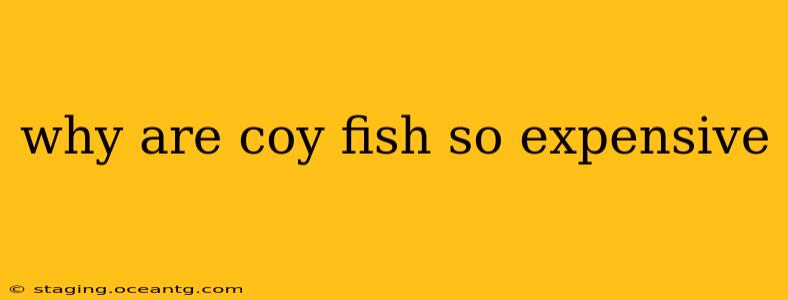Koi fish, with their vibrant colors and graceful movements, are more than just pets; they're living art. Their beauty and elegance, however, come at a price. Many find themselves wondering, "Why are koi fish so expensive?" The answer isn't simple, but lies in a combination of factors that contribute to their high value.
What Factors Determine Koi Fish Price?
Several key factors influence the cost of koi fish, significantly impacting the price you'll pay for these stunning aquatic creatures. These factors include:
Breed and Lineage:
This is arguably the most significant factor. Certain breeds, like the high-end Kohaku, Sanke, and Showa, are highly sought after due to their intricate patterns and exceptional coloration. These koi often come from long lines of prize-winning fish, their lineage meticulously documented and contributing to their elevated value. Think of it like pedigree dogs—the better the bloodline, the higher the price.
Size and Age:
Larger, mature koi are generally more expensive than younger, smaller ones. This is because they've taken years to develop their full coloration and size, representing a significant investment of time and resources by the breeder. A large, fully developed koi is a testament to years of careful breeding and nurturing.
Coloration and Pattern:
The intensity, clarity, and balance of a koi's colors and pattern greatly influence its price. Koi with exceptional, rare patterns and vibrant, clear colors command higher prices. The more visually stunning the fish, the greater the demand and, consequently, the higher the cost.
Quality of Breeding and Care:
The expertise of the breeder significantly affects the price. Reputable breeders employ rigorous selection processes, ensuring only the highest quality fish are bred. They invest in optimal water conditions, nutrition, and disease prevention, all contributing to the health and beauty of the resulting koi. This care translates directly into a higher price tag.
Rarity and Uniqueness:
Extremely rare or unique koi, with exceptional markings or color variations, can fetch incredibly high prices. These fish might be considered "masterpieces" within the koi world, commanding prices in the tens of thousands, or even hundreds of thousands of dollars. The exclusivity drives up the demand, making them highly coveted and expensive.
Are There Cheaper Koi Options?
While top-tier koi can cost a fortune, more affordable options exist. You can find younger, smaller koi or less common varieties at more reasonable prices. However, it's crucial to remember that even "budget-friendly" koi still require specialized care and a properly maintained pond or aquarium. Cutting corners on care can lead to health issues and ultimately shorten the lifespan of your fish.
How Much Does it Cost to Keep a Koi?
Beyond the initial purchase price, remember that owning koi involves ongoing costs. These include:
- Pond construction or aquarium setup: This can range significantly depending on size and complexity.
- Filtration and maintenance: Koi ponds require robust filtration systems.
- Food and medication: High-quality koi food is essential, along with potential medication for diseases.
The total cost of koi ownership over a koi's lifespan, which can be many decades, must be considered when determining if owning one aligns with your budget.
Why are some Koi Fish worth so much money?
This question circles back to the factors mentioned above. Some koi are exceptionally rare, possess unique and exquisite patterns, or come from long lines of prize-winning fish, establishing their high value within the collector's market. It’s a confluence of rarity, beauty, and breeding history that drives their immense worth.
In conclusion, the high cost of koi fish reflects a combination of factors including breed, size, age, coloration, breeding quality, and rarity. While expensive, the beauty and longevity of these fish, along with the dedication required to care for them, make them a rewarding investment for many enthusiasts.
